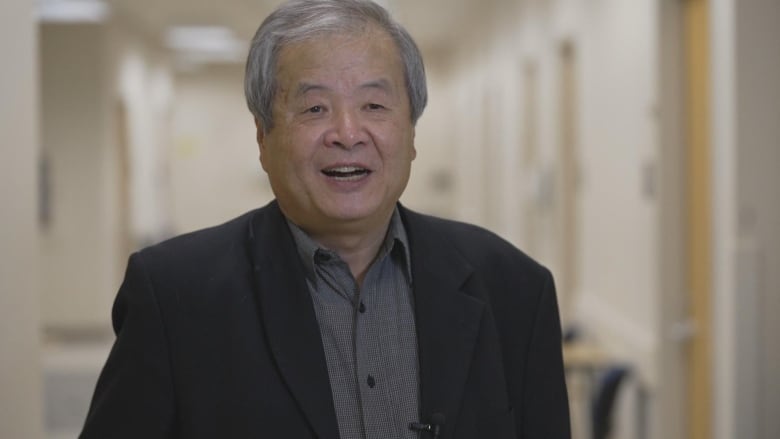How some Calgarians are using boxing and tech to fight back against Parkinson’s disease
It started with her hand shaking.
Shirley Jager began to notice the tremor about 15 years ago, and she decided to visit her family doctor to figure out why. He told her she had Parkinson’s disease.
“It is very difficult for people to understand. Sometimes they think you’re inebriated and sometimes they think that you’re clumsy,” she said.
She began to take medication for the disease, but she knew she wanted to find more activities to keep her busy.
At 79, she found the Grizzly Strides boxing program at Grizzly Boxing and Fitness in northeast Calgary. The program is specifically tailored toward people living with Parkinson’s, allowing them to build up their balance, increase reaction time and interact with other Calgarians living with the disease.
Six years on, Jager says the program is a lifesaver.
“When I’m not able to get here, Parkinson’s does get worse. You shake more … you just get sluggish, slumpy, and it’s like walking around being fuzzy,” she said.
Parkinson’s is a neurodegenerative disease. Most commonly, it causes tremors, problems with balance and slow, stiff walking — freezing, some call it. According to Parkinson Canada, about 100,000 Canadians live with Parkinson’s disease, and the number is rising.
The causes of the disease still need more research, says Karen Lee, CEO of Parkinson Canada.
Aging is a definite risk factor. They’re also looking at the impact of genes, pesticides and other environmental factors.
So far, there is no cure.
“There’s a lot of medications and treatments to help minimize the symptoms that people may have from Parkinson’s disease. It doesn’t stop the disease progression,” Lee said.
“[What’s] really important is how do you live a fulfilling life? And I think doing exercise programs, wellness, are a big component of this.”

Don Mallory, 54, started experiencing Parkinson’s symptoms in his early 30s. It took a while for a diagnosis, he said, since he was so young and there’s no test to make a definitive confirmation.
He’s been with the Grizzly program for about five years and attributes his health and mobility to his passion for exercise.
“People who don’t have Parkinson’s don’t consider the effort that it takes to walk places, for example,” he said.
“It’s maintaining your lifestyle as long as you can to the level which you would like to, and this is just another way of doing it.”
Grizzly Strides
At the boxing gym, participants move through a series of exercises.
They punch lit-up circles with their boxing gloves, duck under cables and work on their footwork and sparring. At the same time, they’re distracted with cognitive challenges, simulating real life.

It’s a program gym owner Darcy Irwin developed in 2016 to improve quality of life for people living with the disease.
“One of the things that we do is we focus on balance and mobility, which we pull from the sport of boxing,” she said.
“When you have Parkinson’s, the balance can be challenged over time, and a fall is the ultimate enemy, in this case. So we’re continually working with the students to be able to help them contend with adversity coming at them.”
Jager immediately noticed a difference in her abilities. When she found the gym six years ago, one of the instructors suggested she try skipping. She practised at home and at the gym, and soon enough, she had it down. Eventually, she moved on to non-combat boxing.
“The boxing stance helps you also in an outdoor environment, the way you stand that it’s not so easy for people to bump into you and knock you over,” she said.

Mallory says he appreciates being able to train with other people who have Parkinson’s.
“So it’s a good social event to try to touch base with someone who’s in the same boat as you, even though the disease affects everyone differently,” he said.
“It really is like a big family.”
But the boxing is just one of the ways he and Jager are fighting back against the disease.
Ambulosono
After a class, Mallory sits down to strap a brace with a small sensor around his knee. It connects to an app called Ambulosono, which plays music when he begins walking.
For him, it’s ’80s rock, like Journey or Def Leppard.
When his movements or his stride gets too small — a symptom of Parkinson’s — the music cuts out. He’ll need to take bigger steps to make it start again.

The person behind the project is Dr. Bin Hu, a professor in the University of Calgary’s department of clinical neurosciences. He specializes in Parkinson’s research.
Although medication and brain stimulation help, he says one of the most promising areas of treatment for the disease is rehabilitation and exercise.
He and his team are examining how a combination of exercise and music therapy encourages participants to increase their stride length, or their gait.
“When your steps are too small, it reminds you. You increase it, and you do it over and over again, and your gait becomes automatically bigger … gradually, it forms a habit,” he said.
The music is also encouraging, he says, as it activates reward pathways in the brain.

The study has been going on for more than a decade, with more than 4,000 participants across the world.
Grizzly Boxing teamed up with the university last year, helping participants to use the app at the gym.
“We’ve seen anecdotal evidence anyways that this is able to help that person to unfreeze.… They’re able to take that next step, regain their regular momentum,” said Irwin.
Mallory has taken part in the study for just over a month.
“Even if it doesn’t specifically help me out, if it can help other people’s Parkinson’s out, then that’s worthwhile doing, for sure,” he said.
Jager is using the app, too.
At the gym, she stands against a wall and practises a high-knee march. When she isn’t lifting her legs high enough, her music — preferably accordion polka songs — stops.
“Movement is the key. The more you slow down, the more you stay down,” she said.
Source: News

